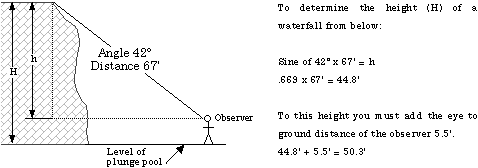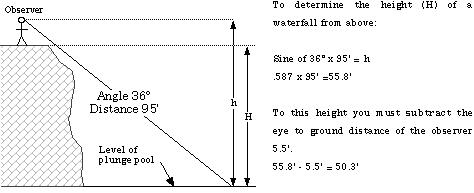|
© 1999 by Scott A. Ensminger
In my research on waterfalls often the most confusing aspect has been in determining the true height of a waterfall. A review of available information on a particular waterfall often reviled two or more heights. Sometimes these heights differed as much as 20 feet (6m) or even more.

But after using this method to determine the height of a few waterfalls, I realized it had a few flaws. Most waterfalls do not have a 100% vertical plunge, and obtaining the distance measurement was sometimes hard, if not dangerous. After consulting a book on trigonometry I began using the following method to determine the height of a waterfall.

In using this method the observer must stand at a point that is level with the plunge pool, which is level with the base of the waterfall. The observer then determines the angle of elevation and distance to the crest. I use a Suunto clinometer to determine the angle. To determine the distance to the crest I use an coincidence rangefinder, an optical device that produces two images of the object that is being viewed. When the images of the object are focused into a single image the distance to the object is indicated. I also use a laser range finder to determine the distance to the crest.
 In determining the height of a waterfall I usually try to take a couple of readings from below the waterfall and a couple of readings from the crest of the waterfall. I then add the results of these readings together and the divide by the total number of readings. I then use this result for the height of the waterfall.
This page hosted by |